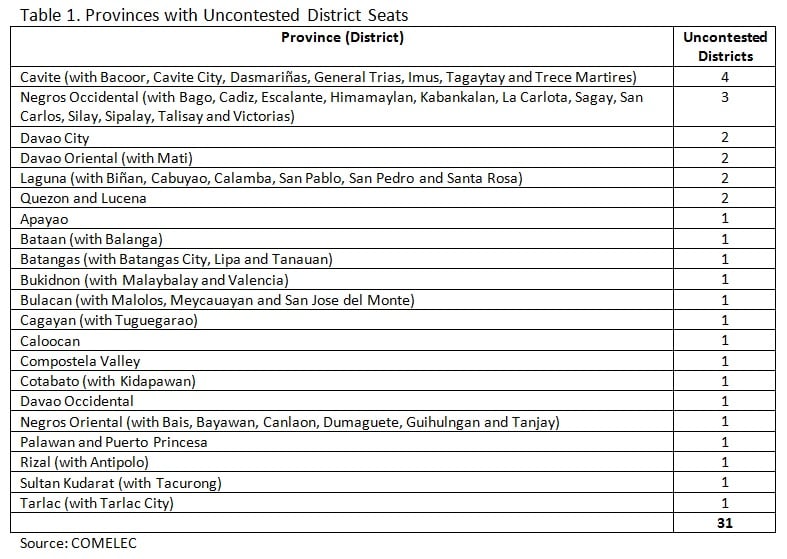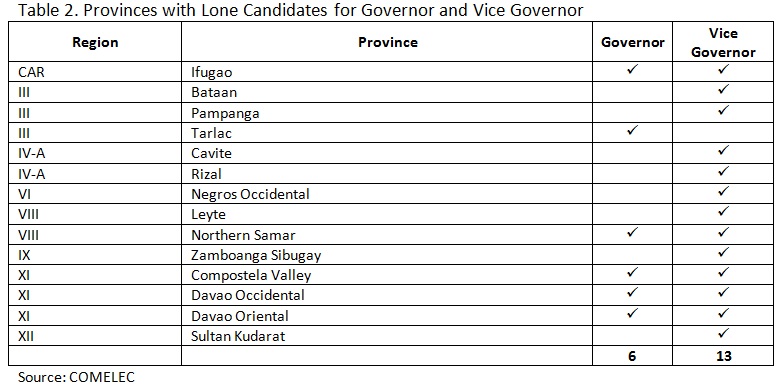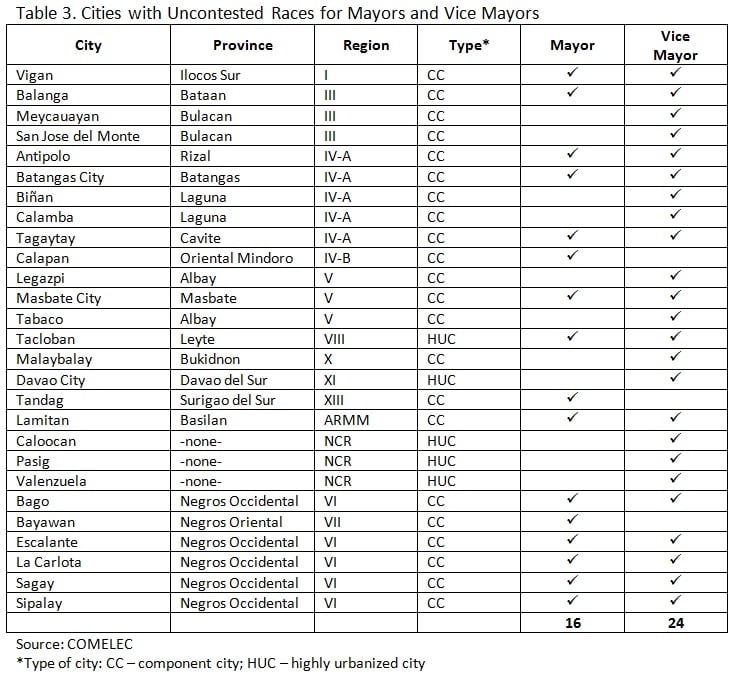
by Jan Robert R. Go*
Aside from electing 12 new members of the Philippine Senate, the Filipino people will also elect 245 district representatives, 81 governors and vice-governors, 145 city mayors and vice-mayors, and 1,489 municipal mayors and vice-mayors, or a total of 3,675 positions up for election at the local level. This means that as much as we give attention to national-level elections, we must also give significant amount of attention to the local political contests.
One particular observation in the recent local elections is the number of uncontested positions. Uncontested positions or seats are those with only one (1) candidate for the positions. Fortunately for these candidates, in our electoral system, a simple plurality of votes or at least one (1) vote can ensure a victory to a lone candidate. For this year’s midterm elections, there is a total of 490 uncontested seats or 13.33% of the total seats up for election. But what does this entail?
In this blog article, I looked at the uncontested seats at the district, provincial, city, and municipal levels. Using the list of candidates from the Commission on Elections (COMELEC), I counted the number of uncontested seats and summarised them. From these, I came up with some observations on the uncontested positions and relate them with previous studies on local elections.
District Representatives
For the district representatives, there are 31 out of 245 seats** (12.65%) which are uncontested. Table 1 shows which provinces have uncontested district representative races. Cavite, which has seven legislative districts, has four uncontested seats. This is followed by Negros Occidental with three of its six legislative districts uncontested for the 2019 elections.
Provincial Governor and Vice-Governor
Five of the 81 provinces have lone candidates for both governor and vice-governor. Of these five, the governor-vice-governor candidates in Davao Occidental share the same surname, Bautista. One trend is that there are more lone candidates for the vice-governor post than the governor. Another observation is that three of the five governor-vice-governor pairs are provinces in Region XI. Table 2 shows the distribution of uncontested races for the provincial chief executives.
Cities
As seen in Table 3, thirteen of 145 cities have uncontested mayoral and vice-mayoral races. Almost half of these are found in Region VI, Western Visayas. In the National Capital Region (NCR), the cities of Caloocan, Pasig, and Valenzuela have uncontested vice-mayoral races. Just like in the provincial races, it is interesting to note that there are more uncontested races for the vice-mayor posts.
Municipalities
Since there are more than 1,400 municipalities, I grouped them by region, as shown in Table 4. Most of the uncontested mayoral races are in Cordillera Administrative Region (CAR), while for vice-mayoral races, it is in Region I. However, if broken down by province, the province with the most uncontested mayoral and vice-mayoral races is Maguindanao (12 races). The Autonomous Region of Muslim Mindanao (ARMM)*** has the most uncontested mayor-vice-mayor tandem. Mayor and vice mayor tandems are those who are running as a tandem (of mayor and vice mayor of a municipality) and in the context of this essay, they are both running uncontested. Of the 17, 11 are from Maguindanao. Maguindanao also has the greatest number of tandems with the same surname. This means the candidates most likely belong to the same family.
In total, there are 177 uncontested seats for mayor, 223 for vice-mayor, 120 mayor-vice-mayor tandems, and 24 tandems from the same family. By this time, we already see that the ‘vice’ position tends to have more uncontested seats.
Elections and uncontested seats
Election can be considered as the expression of the people’s will. Through elections, the voting public can choose the next set of officials who will serve for the next three years. In cases where there is no other option except one, is there still an actual choice?
One of the arguments of an uncontested candidate for a municipal mayor during the 2016 general elections is that being the lone candidate is a testament to the kind or brand of leadership they have provided in the past. Since they have provided the needs and demands of the people, no one thought of challenging their ‘quality’ service. Of course, this kind of argument should be taken with a grain of salt.
Elections have been for the most part a matter of who has the resources, the machinery, and the connections. Looking at the experiences of defeated mayoral candidates in one of my research studies, it shows that their opponents have clearly demonstrated their machinery and ‘overpowered’ them. In an election where money is the fuel, those without money may have a hard time winning the elections. This forces some of the challengers to think twice.
In an interview with a former mayor who lost the election to a more ‘powerful’ contender, she said that since their resources are depleting, there is a lesser chance for her or her husband to enter the electoral contest in the next cycle. If not overpowered, the erstwhile opponents are absorbed by the other group and merged into a faction. This reduces the spending on the part of the candidates while getting their desired end —being elected into office.
Another interesting observation here is the dominance of families in elections. While this is definitely not a new phenomenon in Philippine politics, seeing a single family dominating in uncontested seats solidifies and confirms previous studies on family or dynastic politics, and not of parties. For 2019 local elections, there are at least 25 families from different parts of the country dominating the uncontested seat category. During my examination of the candidates lists, I also saw that in certain contests, members of the same family are vying for the same post. This simply shows how deeply rooted dynasties are.
To end, elections, in general, and uncontested seats, in particular, reflect the political reality we face every day and that of the kind of election system we have —where political families dominate and elections become a contest of who has the most resources to gamble.
* Assistant Professor of Political Science, University of the Philippines Diliman; on study leave
** This does not include the party-list seats.
*** This is not to be confused with the new Bangsamoro Autonomous Region in Muslim Mindanao (BARMM) as instituted by the recent ratification of the Bangsamoro Organic Law (BOL).



